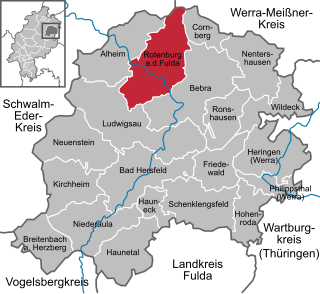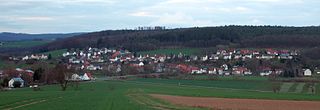
Fritzlar is a small German town in the Schwalm-Eder district in northern Hesse, 160 km (99 mi) north of Frankfurt, with a storied history.

The Eder[ˈeːdɐ] is a 177-kilometre (110 mi)-long major river in Germany that begins in eastern North Rhine-Westphalia and passes in to Hesse, where it empties into the River Fulda.

Felsberg is a town in the Schwalm-Eder district about 25 kilometres south of Kassel.

Gudensberg is a small town in northern Hesse, Germany. Since the municipal reform in 1974, the nearby villages of Deute, Dissen, Dorla, Gleichen, Maden and Obervorschütz have become parts of the municipality.

Jesberg is a community in the Schwalm-Eder district in Hesse, Germany.

Malsfeld is a community in the Schwalm-Eder district in Hesse, Germany, on the river Fulda.

Melsungen is a small climatic spa town in the Schwalm-Eder district in northern Hesse, Germany. In 1987, the town hosted the 27th Hessentag state festival.

Rotenburg an der Fulda is a town in Hersfeld-Rotenburg district in northeastern Hesse, Germany lying, as the name says, on the river Fulda.

Spangenberg is a small town in northeastern Hesse, Germany.

Antrifttal is a community in the Vogelsbergkreis in Hesse, Germany.

Immenhausen is a town in the district of Kassel, in Hesse, Germany. It is located 12 km north of Kassel on the German Timber-Frame Road. The town has 7,098 inhabitants as of July 2020, including the northern village of Mariendorf and eastern village of Holzhausen.
Eppenberg Charterhouse was a charterhouse, or Carthusian monastery, now a ruin, situated on the Eppenberg next to the Heiligenberg in Gensungen, now part of Felsberg in Hesse, Germany. It was established to replace a failing monastery of Premonstratensian canonesses.

The West Hesse Depression is part of the West Hesse Highlands and Lowlands region in the north of the German state of Hesse. Like the East Hesse Depression, it is a series of separate depressions that form a natural corridor and have been an important historical trade route.

Heiligenburg Castle is a castle on the hill of Heiligenberg in the district of Schwalm-Eder-Kreis, Hesse, Germany.
Conrad of Dhaun was a German nobleman. His relatives were the Wild- and Rhinegraves of Dhaun. He was Archbishop and Prince-elector of the Bishopric of Mainz from 1419 until his death as Conrad III. His term was marked by the Hussite wars and by serious disputes with the Landgraviate of Hesse and within the city of Mainz.

Altenbunslar is a small village in North Hesse, Germany. It is part of the town Felsberg.

The Riesenstein is a megalith or menhir, which is situated close to the village of Wolfershausen. It is the largest megalith in the district of Schwalm-Eder-Kreis, Hesse, Germany.
Brunslar was a short-lived municipality in North Hessen, in the now-extinct district of Melsungen, Germany. It was created during the changing of district boundaries on 1 February 1971, when the independent communities of Altenbrunslar and Neuenbrunslar fused. On the 31. December 1971 the community of Wolfershausen joined the Brunslar municipality.

Buchenau is a district of the market town Eiterfeld in the district of Fulda and has around 350 inhabitants.
The Mainz-Hessian War of 1427 was the final military conflict in the two-century long dispute between the Archdiocese of Mainz and Landgrave of Hesse over supremacy of the Hesse region. The decisive victories of Landgrave Ludwig I over the Mainzian military leader Gottfried von Leiningen near Fritzlar and over Archbishop Konrad von Dhaun near Fulda spelled the end of Mainz's ambitions in the Hesse region. The Peace of Frankfurt, signed on December 8, 1427, decisively ended both the war and the long-standing power struggle between Hesse and Mainz.





















